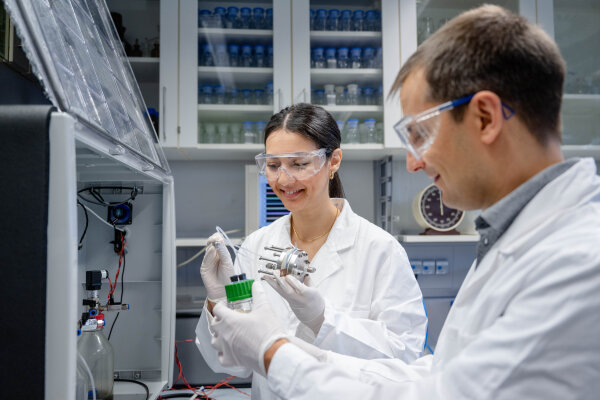22.09.2023

The two working groups of Prof. Dr. Ulf-Peter Apfel and Dr.-Ing. Tito Gehring, research associates at the Chair of Urban Water Management and Environmental Engineering, have developed an innovative technology that enables sewage treatment plants to produce methane from carbon dioxide in an environmentally friendly way. This can be fed into the existing natural gas infrastructure without adaptation.
Although methane has a bad reputation, it has many good properties and potential with regard to the energy transition: it is easier to handle and store than hydrogen. Moreover, like natural gas, it can be used in the existing infrastructure. Natural gas vehicles or heaters could be operated with methane without difficulty, says Tito Gehring. Furthermore, the use of methane will reduce the export of hydrogen, which is produced in southern, water-scarce regions, and thus ultimately of water. They report in the journal Cell Reports Physical Science on 16 August 2023.
The production of methane by bacteria is very efficient and occurs in sewage treatment plants as a component of biogas, so that they can even cover their own energy needs through it. Since biogas only contains 60 per cent methane, the Bochum research groups have developed a new concept. To produce highly concentrated methane, the microorganisms need CO2 as well as hydrogen, which must be added. In order to produce this, the group led by Ulf-Peter Apfel from the Technical Electrochemistry Group and the Electrosynthesis Department of Fraunhofer UMSICHT developed an electrolyser with a precious metal-free catalyst that ensures a long-lasting and energy-efficient supply of hydrogen.
The two working groups of Prof. Dr. Ulf-Peter Apfel and Dr.-Ing. Tito Gehring, research associates at the Chair of Urban Water Management and Environmental Engineering, have developed an innovative technology that enables sewage treatment plants to produce methane from carbon dioxide in an environmentally friendly way. This can be fed into the existing natural gas infrastructure without adaptation.
Although methane has a bad reputation, it has many good properties and potential with regard to the energy transition: it is easier to handle and store than hydrogen. Moreover, like natural gas, it can be used in the existing infrastructure. Natural gas vehicles or heaters could be operated with methane without difficulty, says Tito Gehring. Furthermore, the use of methane will reduce the export of hydrogen, which is produced in southern, water-scarce regions, and thus ultimately of water. They report in the journal Cell Reports Physical Science on 16 August 2023.
The production of methane by bacteria is very efficient and occurs in sewage treatment plants as a component of biogas, so that they can even cover their own energy needs through it. Since biogas only contains 60 per cent methane, the Bochum research groups have developed a new concept. To produce highly concentrated methane, the microorganisms need CO2 as well as hydrogen, which must be added. In order to produce this, the group led by Ulf-Peter Apfel from the Technical Electrochemistry Group and the Electrosynthesis Department of Fraunhofer UMSICHT developed an electrolyser with a precious metal-free catalyst that ensures a long-lasting and energy-efficient supply of hydrogen.
Funding
The work was funded by the German Research Foundation (project code: 445401355 - Establishment of sustainable methanogenic carbon dioxide reduction in bioelectrochemical systems and identification of kinetic and thermodynamic restrictions).
Original publication
Ramineh Rad, Tito Gehring, Kevinjeorjios Pellumbi, Daniel Siegmund, Edith Nettmann, Marc Wichern, Ulf-Peter Apfel: A hybrid bioelectrochemical system coupling a zero-gap cell and a methanogenic reactor for carbon dioxide reduction using a wastewater-derived catholyte, in: Cell Reports Physical Science, 2023, DOI: 10.1016/j.xcrp.2023.101526